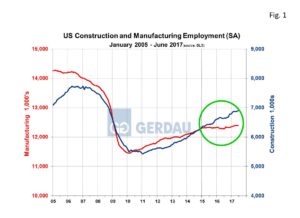Employment by Industry
The Bureau of Labor Statistics (BLS) reported today that there were 222,000 new job created in June. This brings the total number of seasonally adjusted (SA), non-farm people employed in the US in June was 146,404,000, +0.15% month on month, (m/m). Over the past 12 months the US economy has added 2.232 million jobs for an average of 186,000 per month. This represents a +1.55% year on year, (y/y) increase.
The SA goods producing sector employed 20,007,000 people in June, up 25,000, (+0.13%), m/m and by 394,000 (2.01%), y/y. The SA service providing sector employed 126,397,000 people in June, up 197,000 jobs (0.16%), m/m and 1,838,000 (1.48%), y/y. The SA manufacturing sector employed 12,396,000 in June, up 1,000 (+0.01%), m/m and an increase of 107,000 (0.87%), y/y. The two largest employment categories within manufacturing are motor vehicles and parts and transportation equipment. There were 939,300 employed in the manufacture of motor vehicles and parts, off 1,000 m/m but higher by 13,000 y/y. The transportation equipment field employed 1,612,300. Jobs in this sector were down by 3,000 m/m but up 7,000 y/y.
The construction sector employment a total of 6,896,000, up 16,000 (0.23%), m/m and up by 261,000 (3.93%), y/y. Most construction workers are employed constructing buildings. In June there were 1,519,000 workers constructing buildings, down 5,000 m/m but an increase of 61,000 y/y. Heavy civil engineering was the next largest construction segment employing 975,500 in June, up 3,000 m/m and up by 42,000 y/y. Highway, streets and bridge construction, industrial building construction and commercial building construction jobs were not updated in June. In May these three sectors employed 354,500, (+30,100 m/m), 167,700, (-1,900 m/m) and 595,000, (+9,600 m/m) workers respectfully,
 Figure 1, shows US construction and manufacturing jobs on the same chart from 2005 to present. After the great recession ended manufacturing jobs were created at a faster pace than construction jobs. The situation reversed at the beginning of 2015. Since then construction have continued to increase at approximately the same rate, while manufacturing jobs have plateaued. There have been numerous reports that skilled trades’ workers are becoming increasingly difficult to find. This will likely slow the advance of construction job creation going forward.
Figure 1, shows US construction and manufacturing jobs on the same chart from 2005 to present. After the great recession ended manufacturing jobs were created at a faster pace than construction jobs. The situation reversed at the beginning of 2015. Since then construction have continued to increase at approximately the same rate, while manufacturing jobs have plateaued. There have been numerous reports that skilled trades’ workers are becoming increasingly difficult to find. This will likely slow the advance of construction job creation going forward.
Government is a very large employer, greater than the entire goods producing sector with 22,353,000 total employed, up 35,000 m/m and higher by 215,000 y/y. Most of these workers were at the local level, 14,455,000 or 64.7%. State government workers totaled 5,080,000, while the federal government provided jobs for 2,818,000 workers in June. All of the net jobs increase was created at the local level on both a monthly and yearly basis.
The U3 (headline), unemployment rate fell 0.1 points m/m to 4.3% in June. The U6 (which the U3 + includes marginally attached and part-time workers who are unable to find full time work), dropped 0.2 points to 8.4%. Both of the metrics were at their lowest point mid-2007. The economy is still creating jobs at a healthy rate but the rate is expected to slow as the economy approached full employment.
At Gerdau, we keep a keen eye on the employment numbers, especially manufacturing and construction since this is where most long product steel ends-up. In addition we know that growth in net job creation correlates to increased steel consumption.

